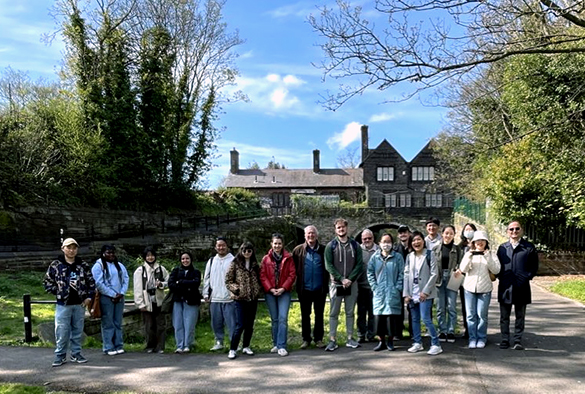University of Liverpool students from the School of Architecture and the Department of Geography and Planning joined together for an intensive, interdisciplinary design workshop proposing design solutions to re-activate Liverpool’s forgotten railway heritage.
The workshop, part of a pilot research project funded by the University’s Early Career Researcher and Returners Fund, was awarded to an interdisciplinary team led by Dr Chia-Lin Chen, Lecturer in Urban Planning as Principal Investigator; and Dr Junjie Xi, Lecturer in Architectural Design and Humanities as Co-Investigator.
The project aims to evaluate Liverpool’s marginalised rail heritage, propose potential visions and enable knowledge exchange and public debate.
In the introduction to the five-day workshop, a series of presentations, including guest talks by Trevor Skempton, former Urban Design Consultant; Liverpool City Council; and Dave Mackereth of the Liverpool and Manchester Community Rail Partnership; as well as site visits to Crown Street Park, Edge Hill station, the Loop Line, and the Wapping Tunnel exit, provided an informative background to Liverpool’s railway heritage.
In the following three days, the focus turned to the Wapping Tunnel. Eddy Taylor, Urban Planning and Design Consultant, and Dr Paco Mejias Villatoro, Lecturer in Architecture at University of Suffolk and Co-director of Open Studio, jointly led the studio work form analyses, mapping design ideas onto maps. Three groups worked on a section of the Wapping Tunnel while all groups were tasked with identifying opportunities and challenges as well as design solutions that interacted with other groups.
Group 1 envisaged Edge Hill station as a key development anchor for rejoining the current divided neighbourhood, improving accessibility and reconnecting with Crown Street Park and the Waterfront/Baltic Triangle, utilising the revitalised Wapping Tunnel as a creative and attractive corridor for work and leisure (group members were Shuai Wang, Xinyi Meng, Alina Angelova, Rowan Bradbury).
Group 2 proposed light wells in the central section, turning the dark tunnel into active, creative and fun spaces, which enhancing the vertical links between different levels and creating new tourist attractions by linking the Crown Street Park, St James Mount and the Gardens through the reimagined tunnel (group members were Wenkang Tian, Zhangze Shao, Alaa Al-Shamahi, Jingwen Tang).
Group 3 took on the Wapping Tunnel Exit near the docklands and Baltic Triangle, and proposed a new multi-modal and multi-level transport and multi-functional hub, where car dependency could be addressed with pleasant and accessible mobility options of (group members were Guo Chen, Millie Mo, Jiajun Zheng, Trudy-Ann Smith).
Finally, the three groups presented their proposals to an interdisciplinary review panel consisting of Dr Patrick Zamarian (Architecture), Dr Urmila Jha Thakur (Planning), Professor John Belchem (History) and Trevor Skempton (Architecture and Urban Design). The panel was impressed with the commitment of the students and offered insightful advice and comments for further development.
Dr Chen said: “This funded project is a great opportunity to build upon our research interests and existing expertise to promote new thinking beyond narrowly defined disciplinary boundaries.
“The process so far has manifested how planning and design disciplines could and should work together to develop strategic and creative solutions.
“We are thrilled that students from architecture and planning worked together enthusiastically, learning from each other beyond the curriculum.
“We believe this small but meaningful step could lead to future revitalisation of the forgotten railway heritage, benefiting local communities and the wider civil society. The next step is to disseminate our research findings and design proposals widely to raise awareness and discussion.”
Dr Xi said: “We are aware of growing interest in preparations for the bi-centenary celebrations in 2030 for the world’s first Inter-city railway between Liverpool and Manchester, which is closely relevant to this project.
“We hope to collaborate and contribute through our research and design output. We anticipate that working together on this research-led and interdisciplinary teaching model between planning and design could advance future curriculum development in addressing complex urban challenges and opportunities.’
To find out more about the Re-Thinking Liverpool’s Railway Heritage project, please visit: www.liverpool.ac.uk/architecture/events/conferencesandexhibitions/re-thinkingliverpoolsrailwayheritage/
